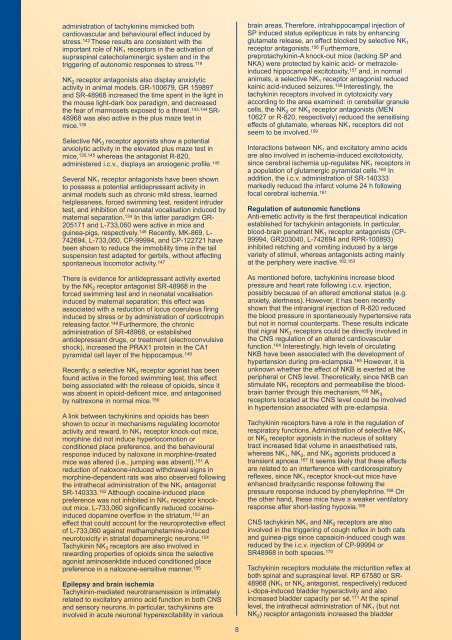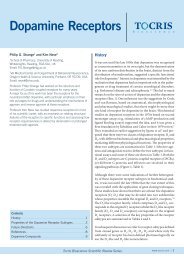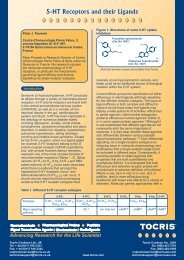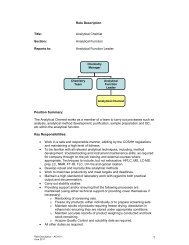Pharmacology and Function of Tachykinin Receptors Pharmacology ...
Pharmacology and Function of Tachykinin Receptors Pharmacology ...
Pharmacology and Function of Tachykinin Receptors Pharmacology ...
Create successful ePaper yourself
Turn your PDF publications into a flip-book with our unique Google optimized e-Paper software.
administration <strong>of</strong> tachykinins mimicked both<br />
cardiovascular <strong>and</strong> behavioural effect induced by<br />
stress. 142 These results are consistent with the<br />
important role <strong>of</strong> NK1<br />
receptors in the activation <strong>of</strong><br />
supraspinal catecholaminergic system <strong>and</strong> in the<br />
triggering <strong>of</strong> autonomic responses to stress. 119<br />
NK2<br />
receptor antagonists also display anxiolytic<br />
activity in animal models. GR-100679, GR 159897<br />
<strong>and</strong> SR-48968 increased the time spent in the light in<br />
the mouse light-dark box paradigm, <strong>and</strong> decreased<br />
the fear <strong>of</strong> marmosets exposed to a threat. 143,144 SR-<br />
48968 was also active in the plus maze test in<br />
mice.<br />
135<br />
Selective NK3<br />
receptor agonists show a potential<br />
anxiolytic activity in the elevated plus maze test in<br />
mice,<br />
135,145<br />
whereas the antagonist R-820,<br />
administered i.c.v., displays an anxiogenic pr<strong>of</strong>ile.<br />
Several NK1<br />
receptor antagonists have been shown<br />
to possess a potential antidepressant activity in<br />
animal models such as chronic mild stress, learned<br />
helplessness, forced swimming test, resident intruder<br />
test, <strong>and</strong> inhibition <strong>of</strong> neonatal vocalisation induced by<br />
maternal separation.<br />
134<br />
In this latter paradigm GR-<br />
205171 <strong>and</strong> L-733,060 were active in mice <strong>and</strong><br />
guinea-pigs, respectively.<br />
146<br />
Recently, MK-869, L-<br />
742694, L-733,060, CP-99994, <strong>and</strong> CP-122721 have<br />
been shown to reduce the immobility time in the tail<br />
suspension test adapted for gerbils, without affecting<br />
spontaneous locomotor activity.<br />
147<br />
There is evidence for antidepressant activity exerted<br />
by the NK2<br />
receptor antagonist SR-48968 in the<br />
forced swimming test <strong>and</strong> in neonatal vocalisation<br />
induced by maternal separation; this effect was<br />
associated with a reduction <strong>of</strong> locus coeruleus firing<br />
induced by stress or by administration <strong>of</strong> corticotropin<br />
releasing factor.<br />
148<br />
Furthermore, the chronic<br />
administration <strong>of</strong> SR-48968, or established<br />
antidepressant drugs, or treatment (electroconvulsive<br />
shock), increased the PRAX1 protein in the CA1<br />
pyramidal cell layer <strong>of</strong> the hippocampus.<br />
149<br />
Recently, a selective NK3<br />
receptor agonist has been<br />
found active in the forced swimming test, this effect<br />
being associated with the release <strong>of</strong> opioids, since it<br />
was absent in opioid-deficent mice, <strong>and</strong> antagonised<br />
by naltrexone in normal mice.<br />
150<br />
A link between tachykinins <strong>and</strong> opioids has been<br />
shown to occur in mechanisms regulating locomotor<br />
activity <strong>and</strong> reward. In NK1<br />
receptor knock-out mice,<br />
morphine did not induce hyperlocomotion or<br />
conditioned place preference, <strong>and</strong> the behavioural<br />
response induced by naloxone in morphine-treated<br />
mice was altered (i.e., jumping was absent).<br />
151<br />
A<br />
reduction <strong>of</strong> naloxone-induced withdrawal signs in<br />
morphine-dependent rats was also observed following<br />
the intrathecal administration <strong>of</strong> the NK1<br />
antagonist<br />
SR-140333.<br />
152<br />
Although cocaine-induced place<br />
preference was not inhibited in NK1<br />
receptor knockout<br />
mice, L-733,060 significantly reduced cocaineinduced<br />
dopamine overflow in the striatum,<br />
153<br />
an<br />
effect that could account for the neuroprotective effect<br />
<strong>of</strong> L-733,060 against methamphetamine-induced<br />
neurotoxicity in striatal dopaminergic neurons.<br />
154<br />
<strong>Tachykinin</strong> NK3<br />
receptors are also involved in<br />
rewarding properties <strong>of</strong> opioids since the selective<br />
agonist aminosenktide induced conditioned place<br />
preference in a naloxone-sensitive manner.<br />
155<br />
Epilepsy <strong>and</strong> brain ischemia<br />
<strong>Tachykinin</strong>-mediated neurotransmission is intimately<br />
related to excitatory amino acid function in both CNS<br />
<strong>and</strong> sensory neurons. In particular, tachykinins are<br />
involved in acute neuronal hyperexcitability in various<br />
145<br />
brain areas. Therefore, intrahippocampal injection <strong>of</strong><br />
SP induced status epilepticus in rats by enhancing<br />
glutamate release, an effect blocked by selective NK1<br />
receptor antagonists. 156 Furthermore,<br />
preprotachykinin-A knock-out mice (lacking SP <strong>and</strong><br />
NKA) were protected by kainic acid- or metrazoleinduced<br />
hippocampal excitotoxity, 157 <strong>and</strong>, in normal<br />
animals, a selective NK1<br />
receptor antagonist reduced<br />
kainic acid-induced seizures. 158 Interestingly, the<br />
tachykinin receptors involved in cytotoxicity vary<br />
according to the area examined: in cerebellar granule<br />
cells, the NK2 or NK3<br />
receptor antagonists (MEN<br />
10627 or R-820, respectively) reduced the sensitising<br />
effects <strong>of</strong> glutamate, whereas NK1<br />
receptors did not<br />
seem to be involved.<br />
159<br />
Interactions between NK1<br />
<strong>and</strong> excitatory amino acids<br />
are also involved in ischemia-induced excitotoxicity,<br />
since cerebral ischemia up-regulates NK1<br />
receptors in<br />
a population <strong>of</strong> glutamergic pyramidal cells.<br />
160<br />
In<br />
addition, the i.c.v. administration <strong>of</strong> SR-140333<br />
markedly reduced the infarct volume 24 h following<br />
focal cerebral ischemia.<br />
161<br />
Regulation <strong>of</strong> autonomic functions<br />
Anti-emetic activity is the first therapeutical indication<br />
established for tachykinin antagonists. In particular,<br />
blood-brain penetrant NK1<br />
receptor antagonists (CP-<br />
99994, GR203040, L-742694 <strong>and</strong> RPR-100893)<br />
inhibited retching <strong>and</strong> vomiting induced by a large<br />
variety <strong>of</strong> stimuli, whereas antagonists acting mainly<br />
at the periphery were inactive.<br />
162,163<br />
As mentioned before, tachykinins increase blood<br />
pressure <strong>and</strong> heart rate following i.c.v. injection,<br />
possibly because <strong>of</strong> an altered emotional status (e.g.<br />
anxiety, alertness). However, it has been recently<br />
shown that the intranigral injection <strong>of</strong> R-820 reduced<br />
the blood pressure in spontaneously hypertensive rats<br />
but not in normal counterparts. These results indicate<br />
that nigral NK3<br />
receptors could be directly involved in<br />
the CNS regulation <strong>of</strong> an altered cardiovascular<br />
function.<br />
164<br />
Interestingly, high levels <strong>of</strong> circulating<br />
NKB have been associated with the development <strong>of</strong><br />
hypertension during pre-eclampsia.<br />
165<br />
However, it is<br />
unknown whether the effect <strong>of</strong> NKB is exerted at the<br />
peripheral or CNS level. Theoretically, since NKB can<br />
stimulate NK1<br />
receptors <strong>and</strong> permeabilise the bloodbrain<br />
barrier through this mechanism,<br />
166<br />
NK3<br />
receptors located at the CNS level could be involved<br />
in hypertension associated with pre-eclampsia.<br />
<strong>Tachykinin</strong> receptors have a role in the regulation <strong>of</strong><br />
respiratory functions. Administration <strong>of</strong> selective NK1<br />
or NK3<br />
receptor agonists in the nucleus <strong>of</strong> solitary<br />
tract increased tidal volume in anaesthetised rats,<br />
whereas NK 1, NK 2, <strong>and</strong> NK3<br />
agonists produced a<br />
transient apnoea.<br />
167<br />
It seems likely that these effects<br />
are related to an interference with cardiorespiratory<br />
reflexes, since NK1<br />
receptor knock-out mice have<br />
enhanced bradycardic response following the<br />
pressure response induced by phenylephrine.<br />
168<br />
On<br />
the other h<strong>and</strong>, these mice have a weaker ventilatory<br />
response after short-lasting hypoxia.<br />
169<br />
CNS tachykinin NK1 <strong>and</strong> NK2<br />
receptors are also<br />
involved in the triggering <strong>of</strong> cough reflex in both cats<br />
<strong>and</strong> guinea-pigs since capsaicin-induced cough was<br />
reduced by the i.c.v. injection <strong>of</strong> CP-99994 or<br />
SR48968 in both species.<br />
170<br />
<strong>Tachykinin</strong> receptors modulate the micturition reflex at<br />
both spinal <strong>and</strong> supraspinal level. RP 67580 or SR-<br />
48968 (NK1 or NK2<br />
antagonist, respectively) reduced<br />
L-dopa-induced<br />
bladder hyperactivity <strong>and</strong> also<br />
increased bladder capacity per sé.<br />
171<br />
At the spinal<br />
level, the intrathecal administration <strong>of</strong> NK 1 (but not<br />
NK ) receptor antagonists increased the bladder<br />
2<br />
8







